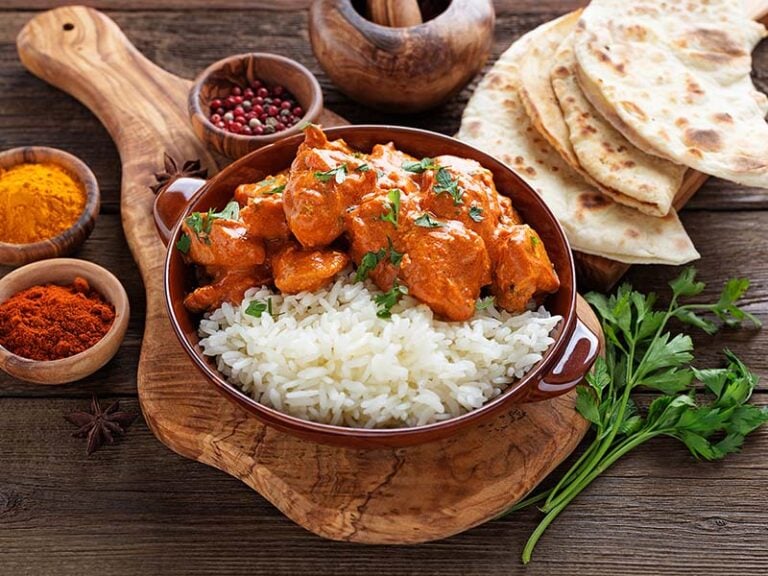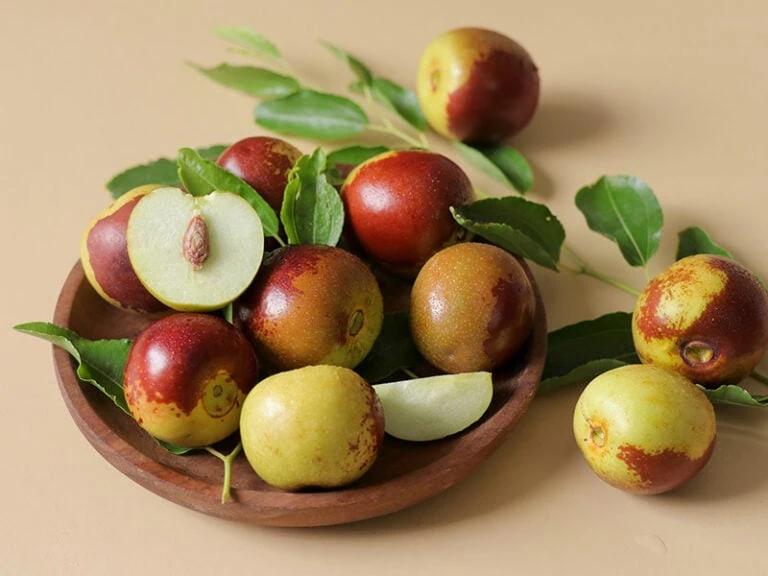It is time to refresh your palate after a heavy meal with mouthwatering Indonesian fruits. Besides the delicious foods, Indonesia is a paradise of many fantastic fruits you should try when traveling to this beautiful country.
In this article, a list of famous Indonesian fruits will be provided. Moreover, the crucial information related to the fruits, such as appearance, flavor, nutrients, season, and the way to eat, will be explicitly presented. Let’s discover them right now.

Incredible Indonesian Seedless Fruits And Having Edible Seeds
In this section, I will introduce the excellent and popular seedless fruits or other choices that have edible seeds. Moreover, you can boil or roast seeds of some fruits to eat as a snack. The information in this part will help you consume these fruits efficiently and adequately.
1. Passion Fruit – Markisa
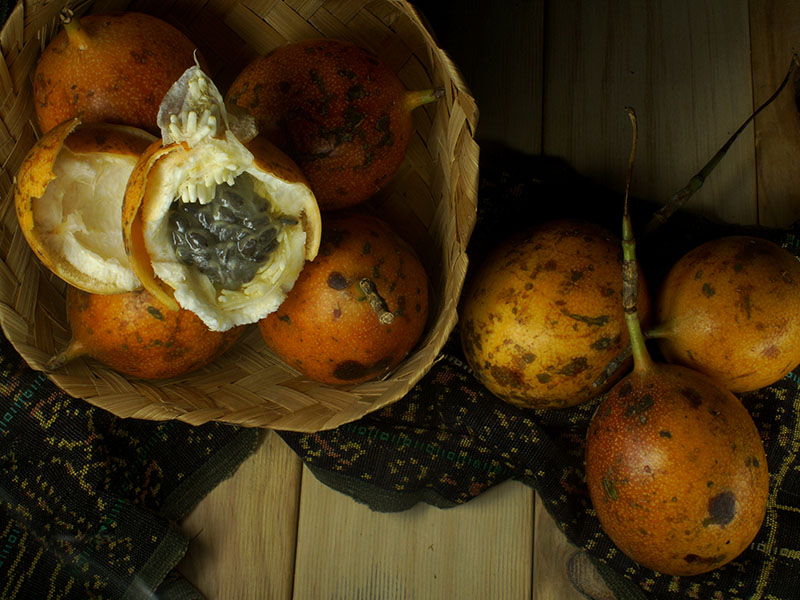
It is a pity not to mention passion fruit or Markisa in this impressive list. Although this fruit is native to South America, it appears commonly in Indonesia and other Southeast Asian countries. Europeans knew about the existence of passion fruit in 1553.
If you want to buy passion fruit at the markets, please choose the fruit with a round or oval shape and red, yellow, green, or purple colors. So, you can identify this fruit quickly, right? Besides, you can find numerous edible seeds in the juicy flesh.
You are able to find 4 different types of passion fruit in Indonesia, including Sweet Granadilla, Yellow passion fruit, Giant Granadilla, and Purple passion fruit. Let’s stimulate your taste buds with a sweet-sour taste. It is used in making juice for summer days.
Nutrients: A rich source of calories, fiber, vitamin A, C, iron, and potassium.
Season: Its peak season extends from November to April in this country.
How to eat: Cut the fruit into 2 halves and get the flesh and seeds out with a spoon.
Follow these instructions to consume passion fruit properly.
2. Dragon Fruit – Buah Naga

You will have an incredible and memorable experience when tasting dragon fruit in Indonesia. This fruit is well-known in Southeast Asia, East Asia, the US, the Caribbean, and subtropical areas worldwide. This fruit got the name “dragon fruit” in 1963.
Its appearance resembles a dragon’s head with leathery rind and scaly spikes on the outside. Many people also call it “Strawberry Pear”. Typically, you can see this fruit in red, pink, or yellow skin, depending on the variety.
There are 3 different types of dragon fruit such as Pitaya Blanca, Pitaya Amarilla, and Pitaya Roja. If you love white flesh and pink skin, you can choose Pitaya Blanca. Pitaya Amarilla has yellow rind and white meat, and the last version is red in skin and flesh.
There is no trouble when consuming the countless tiny edible seeds inside. In particular, the red flesh version will be sweeter than the white one. Most dragon fruits have a mild sweet flavor, and their taste can make you think of the flavors of kiwi and pear.
Nutrients: High in calories, carbs, protein, vitamin C, calcium, and sodium.
Season: This fruit is available from December to May in Indonesia.
How to eat: Let’s consume dragon fruit by peeling the rind and eating its flesh and seeds. Moreover, you can cut it into 2 parts and use a spoon to take the flesh from the shell.
3. Starfruit – Belimbing

Starfruit or Five Fingers is one of the most popular Indonesian fruits. This fruit originates in Southeast Asia and is cultivated commonly in India, Sri Lanka, Brazil, the Caribbean, East Asia, and other tropical regions.
It has a unique appearance with a distinctive shape. You will see 5 to 6 ridges along the sides. So, when cutting it horizontally, you will have star-like slices. You will love the thin and waxy skin of this remarkable fruit.
Typically, this fruit appears orange-yellow on the outside, and the juiciness and crispiness of its yellow flesh will attract you right away. The ripe version will have a mild sweet taste with over 4 percent of sugar content, and you will feel the distinctive tartness.
Generally, this flavor can resemble a mixture of apples, grapes, pears, and citrus fruits. Meanwhile, the taste of unripe starfruit will be more acidic and firmer. Indonesians often use it to make juices, relishes, or jams. Also, you can mix it with sugar, apples, or cloves in a stew.
Nutrients: Fiber, vitamin C, B5, folate, copper, potassium, and magnesium.
Season: It is common between September to August.
How to eat: You can consume the whole fruit after washing it or slice the starfruit to add to salads.
Let’s taste the 10 varieties of starfruit to find the best option.
4. Pineapple – Nanas

This fruit belongs to the Bromeliaceae family and originates in South America. Pineapple appeared in European countries in the 17th century and was planted commonly in the 1820s worldwide.
Indonesians consider pineapples as the “Fruit of wealth and luxury”. Thanks to the tough diamond pattern skin and spines around the fruit, you can realize this fruit quickly. After removing the skin, succulent and yellow flesh will show up.
Ripe pineapples will bring a sexy and fascinating aroma. It is amazing to immerse in the incredible sweet taste and light sourness of this fruit. Palembang city in South Sumatra is the common place for Pineapple planting.
Besides the famous Nanas Palembang in this city, you can taste 2 other different types of pineapple, including Nanas Suban (honey pineapple) and Nanas Bogor. Nanas Bogor is really sweet, while Nanas Suban will be more succulent and expensive.
Indonesians often consume fresh pineapple as a dessert or to make juice. Furthermore, you can find the characteristic flavor in fruit salad or cake. It is a common ingredient in many mouthwatering Indonesian savory dishes.
Nutrients: A source of carbs, protein, calories, vitamin C, and manganese.
Season: It is ripe from December to July in Indonesia.
How to eat: After peeling the skin with a knife, you can cut this fruit into slices or pieces to eat as a dessert.
5. Guava – Jambu Biji

Guava or Jambu Biji is a loved option for many local citizens and tourists in Indonesia. Guava has its origins in Central America, Mexico, South America, and the Caribbean. It is common in tropical and subtropical areas around the world.
Indonesia is one of 4 leading guava producers worldwide, with about 3.1 million tonnes. You can catch many different types of guava in Indonesia and worldwide with various shapes, colors, and flavors. But the apple guava is the most popular variety.
The round and oval shapes are the common forms of this fruit. You can consume the soft and bitter skin, but people often peel it before eating. The skin can be maroon, green, or yellow when ripe. The sourness of it depends on the ripeness level.
Its edible flesh has white or dark pink colors with numerous round and edible seeds. The flavor of guava will tickle your taste buds at the first bite. The perfect sweet taste of guava is suitable for eating raw or making jams, juices, candies, and other desserts.
Nutrients: It includes vitamin C, fiber, folic acid, and calories.
Season: It is ripe between spring and autumn.
How to eat: Peel the thin skin of guava and eat the whole fruit or cut it into small pieces to consume.
6. Banana – Pisang

Banana is a common fruit worldwide, so it is not complicated to catch this fruit in Indonesia. You can consume bananas in the morning, after each meal, or any time in the day because it is nutritional and delicious.
In particular, bananas are diverse in South Asia with many different types of fruit, so you can have many choices to taste. Plantain is a common variety that has green color. It is often used in cooking in some countries.
The first variety of bananas appeared in New Guinea, and this fruit spreads gradually to many regions around the world. Usually, unripe bananas will have a soft green rind and turn yellow, red, purple, or brown when ripe, depending on the species.
Banana fruits form in the banana heart and create tiers with about 20 fruits per one-tier. After removing the leathery skin, fragrant and soft flesh will show up. Its flesh is usually yellow and has a distinctive sweetness.
Occasionally, you can feel a hint of acidity from this fruit. The creamy texture of bananas is suitable for adding to pies, cakes, and desserts. In addition, people use it to make drinks, snacks, or savory dishes.
Nutrients: Rich in calories, carbs, fiber, protein, vitamin C, potassium, magnesium, and phosphorus.
Season: Bananas are available all year round in Indonesia.
How to eat: The simple way to consume banana is to peel the rind and eat the soft flesh.
7. Jackfruit – Nangka

The sweet jackfruit is an ideal suggestion you should consult. It is a member of the Moraceae family and originates in Sri Lanka, Western Ghats, Indonesia, Malaysia, and the Philippines. Nowadays, it is cultivated commonly in tropical regions.
It had the common name “jackfruit” in 1563. This delicious fruit is an indispensable name in the Bangladesh desserts list since it is a national fruit of this country. Jackfruit is a large fruit with various shapes as a jackfruit can weigh from 10 to 25 kilograms.
Commonly, jackfruit appears in ellipsoidal or roundish shapes. Yellowish-greenish and yellow are the standard shades of jackfruit, but almost mature jackfruits have a yellowish-brown hue.
Many small pimples around the rind create hexagonal tubercles on the skin’s surface. It has a fibrous and whitish core, and egg-like achenes will attach to the core. The bright yellow color of its flesh will attract you immediately.
Inside each segment, you can find a seed, and one fruit contains about 100 to 500 seeds. There is no problem consuming the seeds after boiling or roasting. Indonesians often consume fresh jackfruit on its own or dry and fry it to make snacks.
Also, you will be passionate about the amazing taste of the desserts like Es Teler and Es Campur when mixing sliced jackfruit with shaved ice. Gulai Nangka is a well-known stew made from unripe jackfruit.
Nutrients: High in calories, carbs, fiber, protein, vitamin C, E, calcium, magnesium, potassium, and phosphorus.
Season: It is often ripe from March to June or April to September. Moreover, September to December is another season for this fruit.
How to eat: To eat jackfruit, you should cut it into 2 halves and use your hand to separate its segments. Break its flesh and remove the seed before eating.
Let’s diversify your menu by making this jackfruit stew.
8. Durian – Durio
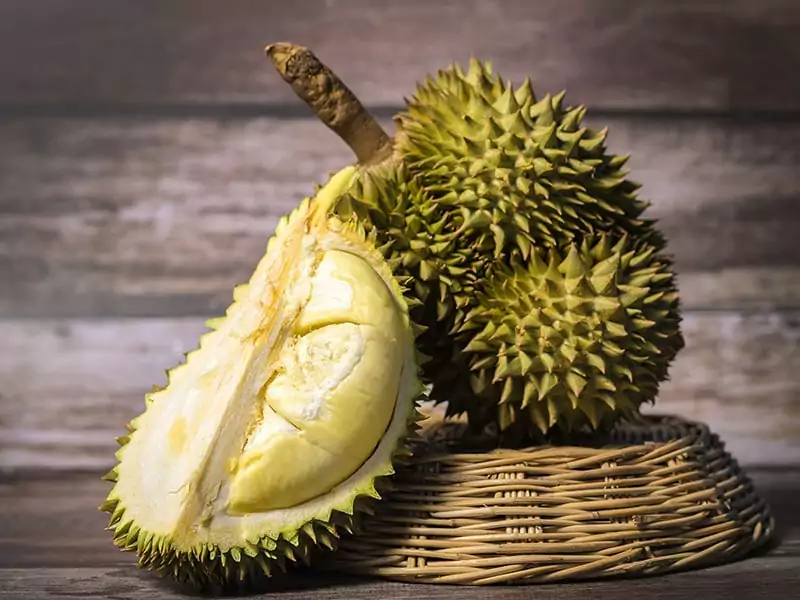
It is an excellent experience if you have a chance to try the unique flavor of durian. People in South Asian countries see it as the “King of Fruits”. Significantly, the intense odor of durian creates a disadvantage for it since it is rare to appear in the public area.
This outstanding fruit is native to Malaysia, Indonesia, Thailand, and the Philippines. In addition, durian is a favorite Vietnamese fruit. You are able to buy durian easily because 30 different types of durian are sold at the market.
This large fruit is often round or oblong shapes and covered by sharp thorn rind. Typically, durian looks distinctive in green or brown colors. You will fall in love with the softness of this fruit’s pale yellow or red flesh.
It has an appealing flavor with sweet, savory, and creamy tastes. Its flavor will make you think of the taste of whipped cream mixed with caramel and diced garlic. The fragrance will wake you immediately.
It has a wide range of uses. You can consume durian as a fruit dessert or mix it in candy, ice cream, milkshakes, and mooncakes. For example, Es Durian (durian ice cream) is a mouth-watering Indonesian street food and dessert.
This fruit is sold on the street vendor in Indonesia. Indonesians combine red flesh versions with freshwater fish to make soup (Sayur).
Nutrients: A source of calories, fat, carbs, fiber, protein, and vitamin C.
Season: You can buy it easily from October to February and June to September in Indonesia.
How to eat: Use a knife to remove the rind, but be careful since its sharp thorns will hurt your hand. Take its segment and eat the flesh around the seed.
9. Tamarind – Asam Java

Tamarind or Asam Java is a popular selection of tourists in Indonesia. The pod-like fruits play an essential role in the cuisine of Indonesia and many countries around the world.
It is also known as Sampalok in the Philippines and appears in many delicious Filipino foods. This unique fruit is derived from the tropical regions of Africa. Gradually, it spread to many areas worldwide. Nowadays, India is the top tamarind producer in the world.
Tamarind is a legume or pod with a firm brown rind. Its flesh is succulent and tart, and it will have brown or reddish-brown hues when ripe. You can find a hint of sweetness in ripe tamarind. There are about 3 to 5 flattened seeds inside this fruit.
You can use tamarind for many purposes. Ripe tamarind is suitable for adding to desserts, juices, ice cream, and drinks. The savory recipes will be better with the sourness of unripe tamarind. Do not leave its seed. Let’s roast them for snacks.
Nutrients: A source of calories, carbs, protein, vitamin C, K, calcium, magnesium, potassium, and phosphorus.
Season: This fruit is available all year round in Indonesia.
How to eat: Remove the skin, eat the flesh, and remove the seeds.
13 Alternative Indonesian Fruits Containing Inedible Seeds
This part includes the delicious and exotic Indonesian fruits you need to remove their seeds while consuming. Let’s check these outstanding choices right now.
10. Mangosteen – Manggis

Mangosteen is a well-known fruit in Asia. Therefore, it is easy to taste it in Indonesia when coming to this nation. It is native to Southeast Asia, Southwest India, and other tropical regions globally. It is famous in the Moluccas and Sunda islands in Indonesia.
Mangosteen cultivation has taken place since ancient times in many Southeast Asian countries. People in the Southeast Asian countries consider it the “Queen of Fruits” because it is loved widely in this region.
The sweetness of this fruit will make you flutter immediately. Besides, the juiciness of its flesh will leave a profound impression on your mind after eating. Its taste is similar to the mixture of peach, strawberries, pineapple, and lychee with a bit of sourness.
You can realize this fruit quickly with its distinctive reddish-purple rind. After cutting it into 2 halves, its white and fragrant flesh will appear. Its flesh contains about 1 to 8 segments, and each segment consists of 1 inedible and almond-like seed.
Mangosteen is an excellent Indonesian dessert when you can consume it raw or make jams and other delicious desserts. Furthermore, it is a good element for skin health, so it also appears in many medical products.
Nutrients: High in calories, carbs, fiber, vitamin C., calcium, phosphorus, potassium, and sodium.
Season: Its season lasts from December to March in Indonesia.
How to eat: Peel the rind of the fruit and separate the segment to eat the flesh around the seed.
11. Langsat – Duku
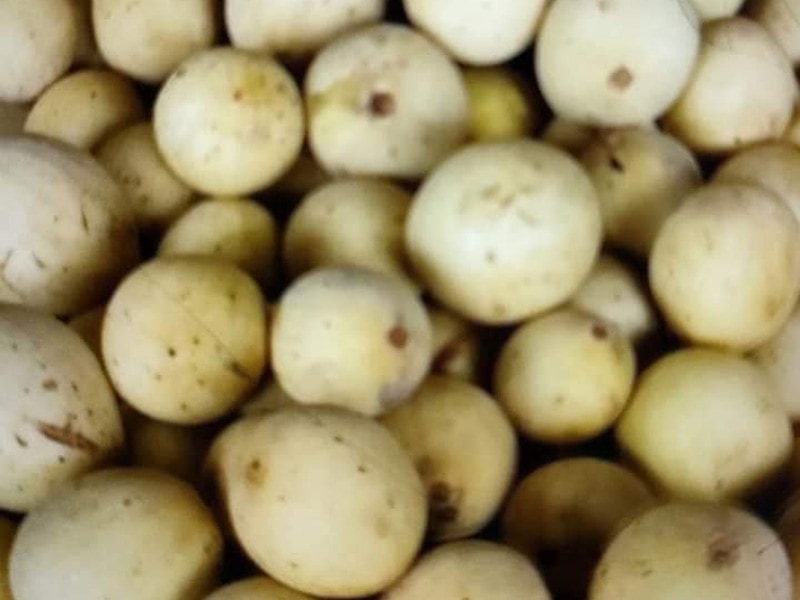
Langsat or Longkang is a member of the Mahogany family, and Indonesians often call it Duku. The Duku is the large version of langsat, and it appears in many delicious Indonesian foods. Southeast Asia is the homeland of this excellent fruit.
The elliptical, round, and oval shapes are the characteristic features of this fruit. It has the same appearance as a small potato, and the flesh is similar to a grape. You will see a layer of yellow hair covering the outside of this fruit.
Beneath the skin, its whitish flesh will captivate you. It looks like peeled garlic with about 5 succulent lobes. There is no seed in the smallest segments, but you should remove seeds in the large segments.
It is a source of sucrose, glucose, and fructose. It is fine to consume the fresh Duku or mix it in many mouthwatering desserts or salads. Primarily, it contains many nutrients that are good to treat diarrhea. Indonesia is the top Duku producer worldwide.
Nutrients: High in fiber, calcium, vitamin A, and phosphorus.
Season: The season extends from January to March in Indonesia.
How to eat: Break the skin with your hand, separate the segment and consume its flesh around the seeds.
12. Snake Fruit – Salak

Snake fruit comes from the palm tree names Salacca or Zalaca. Its unique name has origins from the snakeskin-like peel. It is a local fruit of Indonesia originating in Java and Sumatra. It is cultivated in Bali, Timor, Lombok, and other regions.
Salak is formed in clusters of the palm. It looks outstanding with the reddish-brown scaly rind. Its size and shape are similar to a significant fig. Its edible flesh contains about 2 to 3 lobes with an ample seed in each lobe.
I think of the appearance of peeled garlic when observing the lobes. The sweetness of it will fascinate you. A bit of tartness will leave a deep impression on your mind. Moreover, you can feel a bit of intense astringent taste from it. You can find it in crunchy or moist textures.
There are many different types of Salak, but Salak Pondoh and Salak Bali are the most popular types. Salak Pondoh is native to the Yogyakarta province and has a strong aroma and sweetness.
Meanwhile, Salak Bali is an iconic fruit of Bali Island, and it is native to the Sibetan village on this island. It has about 15 different varieties with sweet and sour tastes depending on each variety. Its flavor resembles the taste of grapefruit.
Nutrients: A source of calories, vitamin C, calcium, iron, and phosphorus.
Season: Its season extends from May to December in Indonesia.
How to eat: After removing the rind, you will eat its segments and remove the seeds.
Do not forget to try snake fruit to understand more about its taste.
13. Soursop – Sirsak

Soursop or Sirsak is one of the well-known fruits in Indonesia. Thanks to the excellent flavor, it is chosen to add to many delicious Indonesian recipes. This fruit originates in the tropical areas of the Caribbean and Americas. It belongs to the Annonaceae family.
Besides the sweet flavor, this fruit also tastes sour. You can feel the flavor of strawberries and apples while eating this fruit. Moreover, a bit of citrus flavor will stimulate your taste buds. You can peel the skin of the ripe version easily as it is tender.
It is straightforward to acknowledge this fruit thanks to its deep green and prickly skin. Usually, soursop has an oval shape and hard texture on the outside. When exploring the inside, you will be impressed by its whitish flesh’s juiciness, fragrance, and softness.
It includes numerous black inedible seeds, so remember to remove them. People love to eat it raw or prepare smoothies, fruit juices, sorbets, and candies with Sirlak. Indonesians often cook this fruit with water and sugar to create a caramelized and hard mixture.
Nutrients: High in calories, carbs, fiber, vitamin C, calcium, magnesium, phosphorus, and potassium.
Season: This fruit is common between June and September in Indonesia.
How to eat: Let’s cut soursop into 2 parts and scoop the flesh with a spoon. Do not forget to remove the seeds while eating.
14. Rose Apple – Jambu Air

When traveling to the streetscapes of neighborhoods in Jakarta, you will catch medium-sized trees with many bell-like small fruits. Rose apple is native to Southeast Asia, and you can find it in many other tropical countries.
It has outstanding waxy and thin skin, and there are no problems when consuming its skin. This skin can be red, pale pink, white, or light green colors. You will love the crunchiness and juiciness of rose apples.
Its flavor is mild, but you can feel tartness from this fruit. Moreover, a floral and sweet taste hint will make you remember it forever. You can imagine the flavor of Asian pear when tasting rose apples.
Typically, Indonesians use it as a fruit dessert. Alternatively, you can see it in many salad recipes and sauteed foods. People often prepare pickles with rose apples.
Nutrients: Plenty of vitamin A, C, calcium, fiber, niacin, potassium, and thiamin.
Season: It is ripe from June to August in Indonesia.
How to eat: It is fine to consume the fruit after rinsing it.
15. Malang Apples – Apel Malang

The Dutch brought apples to Indonesia in the 1930s, and Malang apple is one of the famous varieties you should try in this country. This fruit grows commonly in East Java. Indonesians also call it “Manalagi apples”, and it is not standard outside of Indonesia.
It looks unique in the bright yellow-green shade. Its skin is rough and thick, and its peel is an edible part. The eye-catching white flesh will attract you right away, especially the crunchiness texture that will make you flutter.
I feel its sweetness is higher than other different types of apples. However, it seems drier than other varieties because of the low water content. A bit of tartness will make it more appealing and delicious.
Malang apples are a widespread option to add to savory recipes and cheese platters. Furthermore, it is fantastic to eat fresh Malang apples after each meal to refresh your taste buds.
Nutrients: Rich in vitamin C, fiber, antioxidants, and potassium.
Season: This excellent fruit is available in the autumn.
How to eat: Peel the apples and cut them into small pieces to eat.
16. Rambutan – Kapulasan
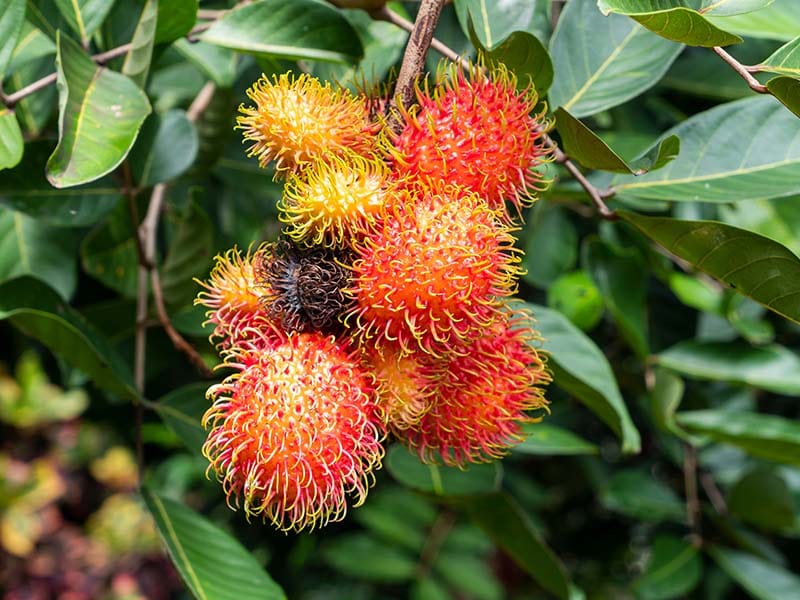
It is a shortcoming not to eat rambutan when visiting Indonesia. It is a local fruit of Southeast Asia originating in the Malaysian-Indonesian region. It is a favorite Thai, Vietnamese, Filipino, and Malaysian fruit. Also, it spread to Africa and Central America.
It is a drupe fruit with a single seed in the middle. The seed is covered by whitish or pale pink flesh. The texture of the flesh is similar to jelly, and it has a sweet flavor and slight tartness that can remind the taste of grapes.
The leathery peel will help you realize it easily. This appearance looks like a head with a lot of hair when covered by pliable spines. This delicious fruit often appears in reddish, yellow, or orange shades and round or oval shapes.
Thailand is the leading rambutan maker worldwide, so you can find it in many Thai recipes. Rambutan cultivation develops strongly in the villages of West Java and Greater Jakarta in Indonesia.
Nutrients: Calories, carbs, vitamin C, calcium, magnesium, phosphorus, potassium, and sodium.
Season: Its season runs from September to April in Indonesia.
How to eat: The fastest way to eat rambutan is to break the skin with your hand and eat the flesh around the seed. Or, you can cut a line on the flesh to remove the seed before eating.
Let’s follow these tutorials to eat rambutan to get its authentic flavor.
17. Mango – Mangga
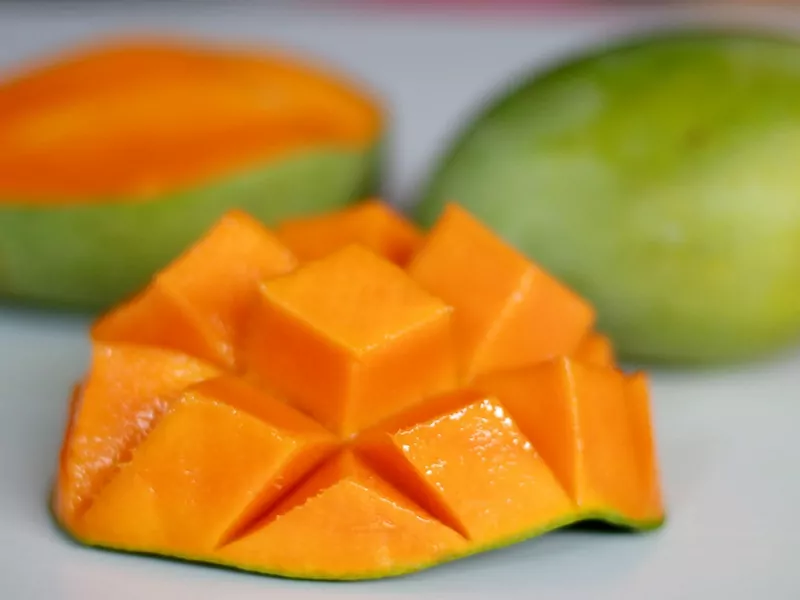
Mango is an indispensable fruit in this great list. This stone fruit is derived from Northwest Myanmar, Bangladesh, and Northeast India. You can easily find fresh mangoes in East and Central Java.
This fruit has existed since ancient times. Nowadays, the Indian type and Southeast Asian type are 2 common mango varieties. In addition, you can find about a hundred different types of mango worldwide.
Besides Indonesia, it is a famous Filipino and Indian fruit, and it is considered a national fruit of Bangladesh. Yellow, orange, green, and red are the standard colors of this fruit. You will be impressed by its smooth, leathery, and waxy skin.
In addition, mango has many sizes and shapes, from oval, round to kidney depending on the variety. Mango is a drupe fruit containing a flat and oblong seed in the middle. You cannot forget the tartness and sweetness of this fruit.
Nutrients: Rich in calories, fiber, vitamin A, C, potassium, and vitamin B6.
Season: Its season runs from June to December, and the peak time is in September in Indonesia.
How to eat: The easy way to eat a mango is to peel its skin and eat around the seed. In addition, you can slice around the stone, cut its flesh, and push the slice up to eat its flesh.
Take a trip to Indonesia to try 5 different types of mango in this country.
18. Avocado – Alpukat

There are many types of fruits you can try in Indonesia, and avocado is one. This delicious fruit is native to the highland areas of Guatemala and South-Central Mexico. Gradually, avocado cultivation occurs widely in many regions worldwide.
Depending on the different types of avocados, you can see them in the brown, green, purplish, or black peel. You can imagine the shapes of a pear or egg when looking at its appearance. The buttery and soft flesh will make you flutter.
You can find the buttery and nutty flavors from this excellent fruit when tasting avocados. Moreover, the earthy and grassy taste will make it more fascinating. It contains a large and inedible pit in the center of the fruit. The Indonesian variety will not be creamier than the Australian one.
Thanks to the suitable climate conditions, Indonesia became one of the top producers of avocado globally, with 0.46 million tonnes in 2019. Indonesians often use avocado in milkshakes, ice cream, smoothies, salads, and other desserts.
Nutrients: Rich in calories, carbs, fiber, fat, vitamin C, E, K, calcium, magnesium, and potassium.
Season: It is common all year-round, but the peak season extends from fall to winter.
How to eat: Cut the fruit into 2 halves, remove the stone in the middle and scoop the flesh from the skin with a spoon.
19. Papaya – Pawpaw

Indonesians often call it “Pawpaw”. It is a member of the Caricaceae family and is native to Southern Mexico and Central America.
Papaya is a berry with an enchanting flavor. This fruit has 3 main sex, including male, female, and hermaphrodite. Typically, unripe papaya will coat green skin and turn yellow or red when ripe. Primarily, you can see countless tiny seeds in the large central cavity.
The flesh of the unripe version is light green and crunchy. However, you will fall in love with ripe papaya’s softness and buttery texture. At this time, it will have red or yellow flesh. You will immerse yourself in the moderate sweetness of this fruit.
There are many ways to consume papaya in Indonesia. You can eat it as a fresh fruit dessert or add it to curries and stews. Moreover, you can prepare salads and sauteed dishes from this fruit.
Nutrients: High in calories, carbs, vitamin C, calcium, magnesium, potassium, and phosphorus.
Season: It is available all year round in Indonesia.
How to eat: Cut papaya into 2 parts and remove the seeds. Use a spoon to get the flesh out to consume.
20. Longan – Lengkeng

This delicious fruit is native to China and tropical regions in Asia. Its name means “Dragon Eye” in Chinese because of the similarity between this fruit and eyeball.
Longan often forms in the round with the leathery and tan peel. It is easy to break its skin with your hands, and the whitish and succulent flesh will appear in front of your eyes. The texture of its flesh is similar to rambutan and lychee.
The appealing sweetness of longan will captivate you right away. You can feel a bit of muskiness while eating this fruit. There is a single round and black seed inside the flesh. This is a long-standing fruit since it existed in the Han Dynasty in 200 BC.
People often taste longan after each meal as a sweet dessert. Moreover, it appears in many yummy Asian foods, such as snacks, soups, and syrup. In particular, it is also a herbal medicine in China and many other countries.
Nutrients: High in calories, carbs, protein, vitamin C, calcium, phosphorus, magnesium, and potassium.
Season: This fruit is common in the summer months in Indonesia.
How to eat: Use your hand to peel the skin of longan and consume the flesh around the seed.
21. Ambarella – Kedondong

Ambarella or Kedondong is the must tried-fruit in Indonesia. People in the Caribbean usually call it the “Golden Apple”. Melanesia and Polynesia are the homelands of this well-known fruit. It started becoming famous across the world in the 18th century.
Ambarellas often attach to a bunch with about more than 12 fruits. This fruit often appears oval and green in color when immature. It will have golden-yellow skin when ripe. The flesh is green and crunchy and covers a single pit.
Its dominant flavor is acidity and a light sweetness. In Indonesia, people often eat raw ambarella with shrimp paste, chili salt, or salty-sweet sauce. In addition, you can feel its taste in soups, stews, and sauces.
Nutrients: It is time to add calories, carbs, protein, calcium, vitamin A, C, and iron to your body.
Season: This fruit is available from autumn to winter in Indonesia.
How to eat: You can eat the meat around the pit after rinsing. Or peel the skin before eating to ensure sanitation.
Listen to some essential health values of delicious ambarella right now.
It Is Time To Refresh Your Mouth!
Do you love the fruits I have shown in this article? It is an exciting experience when you refresh your palate with these fresh and delicious fruits with your friends and relatives after each meal on the trip to Indonesia.
After reading this post, I am sure that your knowledge about Indonesian fruits will be expanded. I hope that this article will make your travel more interesting. Let’s share your thoughts in the comment section. Thanks for your time!


